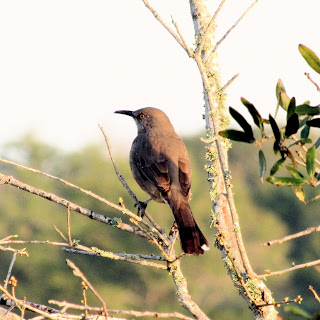Welcome to my world!
Backyard Birding in the Rio Grande Valley of South Texas:
Surrounded by great birding destinations, our favorite patch is still the backyard (or the front), where we've seen more than 270 species of birds. Sit awhile, and watch the river and yard with us!
Surrounded by great birding destinations, our favorite patch is still the backyard (or the front), where we've seen more than 270 species of birds. Sit awhile, and watch the river and yard with us!
Wednesday, March 3, 2010
Early Birds
The first bird I see on winter mornings is often the cheerful Orange-crowned Warbler. I hear its chip note, a sharp "tick", and see it flitter in to the hummingbird feeder. Inevitably it is the first to find a new orange-half on the edge of the deck and the first to taste fresh sugar water. Field guides describe this guy as "drab" or "nondescript," but it's one of my favorite winter visitors. Some are brighter than others. The one above seemed quite yellow in the morning sun but most of them are a duller olive with yellow under the tail and along the margins of the wing coverts. (The photo turned out a little too bright perhaps, but that makes it look even more sunny--appropriate for my first picture of the day. If it's more yellow than reality, we'll just call it metaphorical.) In good light you can see faint brownish stripes on the breast and a light yellowish eye-ring that looks broken because there's also a faint brown streak through the eye. These birds are easy to study because they will stay put to eat oranges and nectar even if I'm sitting only a few feet away.
Thrashers are also early risers. This Long-billed Thrasher was singing from the top of a live oak tree in the backyard this morning, and a pair of Curve-billed Thrashers investigated a brush pile.
A few winters ago a Brown Thrasher hung out in the yard for awhile. It was neat to be able to see the Long-billed and Brown Thrasher side by side in the drive. Although similar species, there are differences that can be seen when you have time to compare. The Brown Thrasher was redder, especially on its head, and its eye was yellow instead of orange.
Last summer in Missouri I watched Brown Thrashers that nest in my son's yard and sensed a slightly more streamlined look to them than to the Long-billed Thrashers that nest here. (Of course that may be only my impression and may not be true at all if I were able to carefully and scientifically measure. It was just that sense you get of a bird when you get to observe it day after day in your yard.)
Whenever I see a Brown Thrasher or a Catbird or an American Robin in the winter here, (uncommon birds for South Texas), I am reminded of the common birds of Oklahoma where we grew up. I would not want to be living anywhere else but here on the banks of the Arroyo Colorado, but sometimes I am nostalgic for those birds from the yard of my childhood.
My dad gave me my first Peterson Field Guide when I was eight (and had the measles), and he patiently pointed out the differences in various sparrows that came to the seed he sprinkled on a table outside when it snowed. In my favorite photograph of him, he is sitting in his chair with a newspaper on his lap and the bird feeding table visible through a picture window behind him. Snow covers the ground but the table is covered with little brown birds waiting to be identified by a child and her dad.
Subscribe to:
Post Comments (Atom)



2 comments:
What a wonderful memory of your dad! I often wish my parents had been tuned in to nature while I was growing up. Enjoyed today's post very much. When I visit TX in the winter, the orange-crowns are ubiquitous, to be sure! I have some nice photos! There are a lot of birds that don't travel as far N as my Cape Breton retreat that I miss, too. ~karen
Great post Kay. The description of you and your dad is heartwarming to say the least.
The Orange-crowned Warbler and Long-billed Thrasher shots are beautiful and if you could see me, I am green with envy over your ability to observe 250 species from your porch. You definitely live a charmed life!
Post a Comment